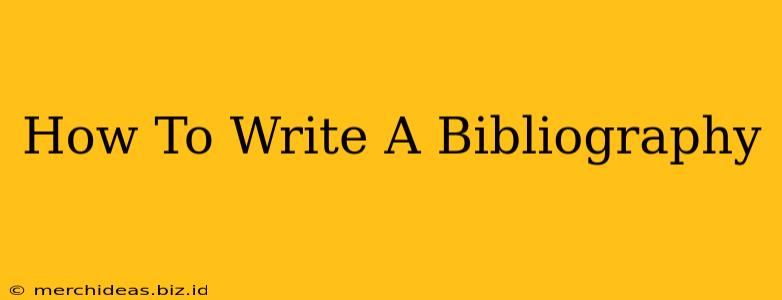Creating a bibliography might seem daunting, but it's a crucial skill for academic success and showcasing your research. A well-formatted bibliography demonstrates your credibility and allows readers to easily verify your sources. This guide will walk you through the process step-by-step, covering different citation styles and offering helpful tips for accuracy and efficiency.
Understanding the Purpose of a Bibliography
A bibliography is a list of all the sources you consulted while researching your work, regardless of whether you directly cited them in the text. It's different from a works cited page, which only includes sources you specifically referenced. Think of it as a comprehensive overview of your research journey. A strong bibliography adds weight to your arguments and demonstrates the breadth of your research.
Key Benefits of a Well-Structured Bibliography:
- Academic Integrity: Properly citing your sources avoids plagiarism and demonstrates ethical research practices.
- Credibility Enhancement: A thorough bibliography establishes your research's credibility and showcases the depth of your investigation.
- Reader Accessibility: It allows readers to easily locate and examine the sources you used, encouraging further exploration of the topic.
- Improved Research Skills: The process of compiling a bibliography hones valuable research and organizational skills.
Choosing the Right Citation Style
The style of your bibliography depends on the requirements of your assignment or publication. Some common citation styles include:
-
MLA (Modern Language Association): Frequently used in the humanities, MLA style emphasizes author-page citations within the text and a corresponding bibliography listing works alphabetically by author's last name.
-
APA (American Psychological Association): Commonly used in the social sciences, APA style utilizes in-text citations with author, year, and page number, followed by a reference list organized alphabetically.
-
Chicago/Turabian: Offers both a notes-bibliography system (footnotes/endnotes paired with a bibliography) and an author-date system similar to APA. Often used in history and other humanities disciplines.
-
IEEE (Institute of Electrical and Electronics Engineers): Used primarily for technical and scientific publications, IEEE style utilizes numerical citations and a corresponding bibliography.
Step-by-Step Guide to Creating a Bibliography
Regardless of the citation style you choose, the process generally involves these steps:
1. Gather Your Sources
Collect all the materials you used during your research. This includes books, journals, articles (both print and online), websites, interviews, and any other relevant sources. Keep track of the source details as you go – this will save you time later.
2. Select Your Citation Style
Determine the required citation style for your assignment or publication. Your instructor or editor should provide clear guidelines.
3. Consult a Style Guide
Utilize a comprehensive style guide specific to your chosen citation style. Many universities and colleges offer online resources and style manuals. These guides provide detailed instructions on formatting each type of source.
4. Create Entries for Each Source
Carefully record all necessary information for each source, including author(s), title, publication information (publisher, date, journal name, volume, issue, page numbers), and URL for online sources. Accuracy is paramount.
5. Organize and Format Your Bibliography
Alphabetize your entries by the author's last name (or the first significant word in the title if there is no author). Use consistent formatting throughout your bibliography. Pay close attention to punctuation, capitalization, and spacing, as these elements vary depending on the chosen style.
6. Proofread Thoroughly
Before submitting your work, meticulously proofread your bibliography for any errors in spelling, punctuation, or formatting. A clean, error-free bibliography significantly impacts your credibility.
Tips for Effective Bibliography Creation
- Start Early: Don't leave bibliography creation until the last minute. Gathering and formatting information takes time.
- Use Citation Management Software: Tools like Zotero, Mendeley, or EndNote can streamline the process by helping to organize your sources and generate citations automatically.
- Double-Check Accuracy: Verify all details before including them in your bibliography. Inaccurate information can damage your credibility.
- Seek Help When Needed: If you are unsure about any aspect of bibliography creation, consult your instructor, librarian, or online style guides.
By following these steps and tips, you can confidently create a professional and accurate bibliography that strengthens your academic work. Remember, a well-crafted bibliography is more than just a list of sources; it's a reflection of your research process and your commitment to academic integrity.
